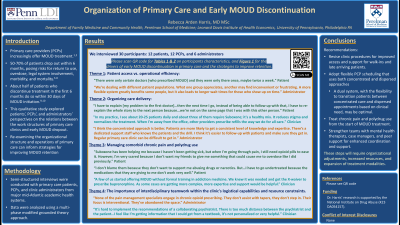Back


(82) Organization of Primary Care and Early MOUD Discontinuation
Saturday, April 6, 2024
9:45 AM – 1:15 PM

Has Audio

Rebecca A. Harris, MD, MSc
Assistant Professor of Family Medicine and Community Health
University of Pennsylvania, Pennsylvania
Presenter(s)
Background & Introduction: Over 5 million individuals in the United States have Opioid Use Disorder (OUD).[1] Buprenorphine, a first-line FDA-approved medication for OUD (MOUD), is increasingly prescribed by primary care physicians (PCPs).[2] Primary care offers a more private and less stigmatizing setting for substance use treatment, yet 50-70% of patients in treatment discontinue within the first year,[3] increasing risks of illicit drug use, morbidity, overdose mortality, legal system involvement, and spread of HIV/HCV.[4]
About half of patients who discontinue treatment do so within the first month of initiation.[3,5] Patients may be particularly vulnerable to discontinuation during the initial weeks of MOUD treatment because they have acute medical and psychosocial needs and have not yet formed trusting, supportive relationships with care team members. Given the high rates of early discontinuation and patient challenges, understanding the potential role of primary care's organizational structure in MOUD discontinuation presents a strategic opportunity for improvement.
This qualitative study explores the association between the work-structures of primary care clinics and early MOUD discontinuation. It examines the perspectives of patients, PCPs, and administrators on early treatment discontinuation in primary care settings, aiming to identify clinic-level factors that contribute to treatment discontinuation.
Methods: Semi-structured interviews were conducted with patients, PCPs, and clinic administrators. Patients were 18 years or older and received MOUD from a PCP affiliated with a major mid-Atlantic academic health system with a large catchment area. They were selected using purposive sampling to ensure diversity in patient characteristics and experiences based on race, sex, and community setting (urban to rural). Patient participants received nominal compensation after giving informed consent. PCPs with addiction medicine training and top-level clinic administrators were also recruited. All PCPs and administrators volunteered to be interviewed without compensation.
The interview guides were structured into three sections: clinic structure and operations, patient care experience, and perceived clinic factors linked to early MOUD discontinuation. Guides were developed from a literature review, our previous research, and clinical experience.
Analysis followed a modified grounded theory approach, using NVivo software for coding. Finally, patient interviews were analyzed, themes were identified, and representative quotes were selected to illustrate the findings.
The University of Pennsylvania’s IRB approved this human subjects research.
Results: Thirty participants (12 patients, 12 PCPs, and 6 administrators) were interviewed. Four themes emerged from the coding and analysis:
Accessibility vs. Efficiency. Patients who completed the first four weeks of MOUD typically kept their appointments without complications; in contrast, those who discontinued early had more difficulty, requesting walk-in or same-day options. However, PCPs and administrators generally discouraged walk-ins because it made patient volume and staffing levels hard to predict. Clinics struggled to find a workable balance between flexible and accessible appointments to reduce early MOUD dropout while maintaining efficiency and revenue targets.
Organizational design. The study compared two approaches to OUD care delivery. In the "dispersed arrangement," patients with OUD were integrated into the regular schedules of PCPs, enhancing continuity and potentially reducing stigma and dropout. However, incorporating frequent MOUD appointments into busy schedules often led to challenges in maintaining regular sessions and rescheduling missed appointments, increasing early dropout. Conversely, the "concentrated arrangement" dedicated specific half-days to MOUD, providing focused care and additional support (e.g., case managers, social workers, peer support workers). This method, confining care to set times and often managed by a rotating MOUD-experienced PCPs, was more favored when multiple MOUD days per week were feasible. PCPs and administrators noted that the concentrated model was more practical in larger, well-resourced clinics and was likely to be more successful in reducing early dropout.
Comorbidities. Participants noted that comorbidities like chronic pain, methamphetamine addiction, and benzodiazepine use disorder complicated OUD treatment, leading to higher dropout rates. Patients with chronic pain often discontinued treatment when MOUD failed to relieve pain. Benzodiazepine use disorder posed tapering challenges and, due to overdose concerns, PCPs' hesitancy in prescribing led some patients to illicit alternatives, increasing dropout. The lack of methamphetamine addiction treatments and prolonged waits for behavioral health care, focusing treatment mainly on OUD, also contributed to dropout. There was a strong consensus among patients, PCPs, and administrators on the need for enhanced support for these high-risk patients at the start of treatment.
Multidisciplinary collaboration. Participants emphasized the need for multidisciplinary treatment approaches and alternative therapies like contingency management, to reduce early dropout. They pinpointed barriers: pain specialists' preference for procedural over collaborative opioid management, psychiatrists' limited Medicaid acceptance or lengthy waitlists, inadequate reimbursements, and the absence of leaders for program initiation. PCPs and administrators expressed willingness to adopt new strategies, as long as they integrated smoothly into current workflows and received adequate funding.
Conclusion & Discussion: This study explored the impact of primary care clinic structures and business cultures on early MOUD discontinuation, considering patient, PCP, and administrator perspectives. It highlighted the challenge of balancing accessibility with operational efficiency, suggesting strategies like reserving same-day visit slots, allocating buffer times, and using telehealth to fill cancellations, though these require substantial resources.
Interviews also revealed that early dropout is influenced by clinic organizational design. Larger clinics with MOUD-experienced PCPs may favor the concentrated approach, while smaller clinics might benefit from the dispersed model. A common factor in early discontinuation was patients consulting multiple PCPs, emphasizing the importance of PCP continuity in early treatment.
The study also identified chronic pain and polydrug use as significant factors in early dropout, necessitating multidisciplinary collaboration and comprehensive services, which can be costly and impractical for many primary care clinics operating on tight budgets.
Study's limitations include the focus on better-resourced academic primary care clinics in the Mid-Atlantic region, which may not reflect the realities of community-based primary care settings, and the potential for participation bias. There needs to be a dedicated funding stream for MOUD care.
References: 1. Substance Abuse and Mental Health Services Administration. (2022). Key substance use and mental health indicators in the United States: Results from the 2021 National Survey on Drug Use and Health (HHS Publication No. PEP22-07-01-005, NSDUH Series H-57). Center for Behavioral Health Statistics and Quality, Substance Abuse and Mental Health Services Administration. Retrieved May 20, 2023, from https://www.samhsa.gov/data/report/2021-nsduh-annual-national-report
2. Whelan, P. J., & Remski, K. (2012). Buprenorphine vs methadone treatment: A review of evidence in both developed and developing worlds. Journal of Neuroscience in Rural Practice, 3, 45-50.
3. Lagisetty P, Klasa K, Bush C, Heisler M, Chopra V, Bohnert A. Primary care models for treating opioid use disorders: What actually works? A systematic review. PLoS One. 2017 Oct 17;12(10):e0186315. doi: 10.1371/journal.pone.0186315. PMID: 29040331; PMCID: PMC5645096.
4. Watkins, K. E., Ober, A. J., Lamp, K., et al. (2017). Collaborative care for opioid and alcohol use disorders in primary care: The SUMMIT randomized clinical trial. JAMA Internal Medicine, 177(10), 1480-1488.
5. Noe, S. R., & Keller, T. (2020). Office-based buprenorphine treatment: Identifying factors that promote retention in opioid-dependent patients. Journal of Addictions Nursing, 31, 23-29.
About half of patients who discontinue treatment do so within the first month of initiation.[3,5] Patients may be particularly vulnerable to discontinuation during the initial weeks of MOUD treatment because they have acute medical and psychosocial needs and have not yet formed trusting, supportive relationships with care team members. Given the high rates of early discontinuation and patient challenges, understanding the potential role of primary care's organizational structure in MOUD discontinuation presents a strategic opportunity for improvement.
This qualitative study explores the association between the work-structures of primary care clinics and early MOUD discontinuation. It examines the perspectives of patients, PCPs, and administrators on early treatment discontinuation in primary care settings, aiming to identify clinic-level factors that contribute to treatment discontinuation.
Methods: Semi-structured interviews were conducted with patients, PCPs, and clinic administrators. Patients were 18 years or older and received MOUD from a PCP affiliated with a major mid-Atlantic academic health system with a large catchment area. They were selected using purposive sampling to ensure diversity in patient characteristics and experiences based on race, sex, and community setting (urban to rural). Patient participants received nominal compensation after giving informed consent. PCPs with addiction medicine training and top-level clinic administrators were also recruited. All PCPs and administrators volunteered to be interviewed without compensation.
The interview guides were structured into three sections: clinic structure and operations, patient care experience, and perceived clinic factors linked to early MOUD discontinuation. Guides were developed from a literature review, our previous research, and clinical experience.
Analysis followed a modified grounded theory approach, using NVivo software for coding. Finally, patient interviews were analyzed, themes were identified, and representative quotes were selected to illustrate the findings.
The University of Pennsylvania’s IRB approved this human subjects research.
Results: Thirty participants (12 patients, 12 PCPs, and 6 administrators) were interviewed. Four themes emerged from the coding and analysis:
Accessibility vs. Efficiency. Patients who completed the first four weeks of MOUD typically kept their appointments without complications; in contrast, those who discontinued early had more difficulty, requesting walk-in or same-day options. However, PCPs and administrators generally discouraged walk-ins because it made patient volume and staffing levels hard to predict. Clinics struggled to find a workable balance between flexible and accessible appointments to reduce early MOUD dropout while maintaining efficiency and revenue targets.
Organizational design. The study compared two approaches to OUD care delivery. In the "dispersed arrangement," patients with OUD were integrated into the regular schedules of PCPs, enhancing continuity and potentially reducing stigma and dropout. However, incorporating frequent MOUD appointments into busy schedules often led to challenges in maintaining regular sessions and rescheduling missed appointments, increasing early dropout. Conversely, the "concentrated arrangement" dedicated specific half-days to MOUD, providing focused care and additional support (e.g., case managers, social workers, peer support workers). This method, confining care to set times and often managed by a rotating MOUD-experienced PCPs, was more favored when multiple MOUD days per week were feasible. PCPs and administrators noted that the concentrated model was more practical in larger, well-resourced clinics and was likely to be more successful in reducing early dropout.
Comorbidities. Participants noted that comorbidities like chronic pain, methamphetamine addiction, and benzodiazepine use disorder complicated OUD treatment, leading to higher dropout rates. Patients with chronic pain often discontinued treatment when MOUD failed to relieve pain. Benzodiazepine use disorder posed tapering challenges and, due to overdose concerns, PCPs' hesitancy in prescribing led some patients to illicit alternatives, increasing dropout. The lack of methamphetamine addiction treatments and prolonged waits for behavioral health care, focusing treatment mainly on OUD, also contributed to dropout. There was a strong consensus among patients, PCPs, and administrators on the need for enhanced support for these high-risk patients at the start of treatment.
Multidisciplinary collaboration. Participants emphasized the need for multidisciplinary treatment approaches and alternative therapies like contingency management, to reduce early dropout. They pinpointed barriers: pain specialists' preference for procedural over collaborative opioid management, psychiatrists' limited Medicaid acceptance or lengthy waitlists, inadequate reimbursements, and the absence of leaders for program initiation. PCPs and administrators expressed willingness to adopt new strategies, as long as they integrated smoothly into current workflows and received adequate funding.
Conclusion & Discussion: This study explored the impact of primary care clinic structures and business cultures on early MOUD discontinuation, considering patient, PCP, and administrator perspectives. It highlighted the challenge of balancing accessibility with operational efficiency, suggesting strategies like reserving same-day visit slots, allocating buffer times, and using telehealth to fill cancellations, though these require substantial resources.
Interviews also revealed that early dropout is influenced by clinic organizational design. Larger clinics with MOUD-experienced PCPs may favor the concentrated approach, while smaller clinics might benefit from the dispersed model. A common factor in early discontinuation was patients consulting multiple PCPs, emphasizing the importance of PCP continuity in early treatment.
The study also identified chronic pain and polydrug use as significant factors in early dropout, necessitating multidisciplinary collaboration and comprehensive services, which can be costly and impractical for many primary care clinics operating on tight budgets.
Study's limitations include the focus on better-resourced academic primary care clinics in the Mid-Atlantic region, which may not reflect the realities of community-based primary care settings, and the potential for participation bias. There needs to be a dedicated funding stream for MOUD care.
References: 1. Substance Abuse and Mental Health Services Administration. (2022). Key substance use and mental health indicators in the United States: Results from the 2021 National Survey on Drug Use and Health (HHS Publication No. PEP22-07-01-005, NSDUH Series H-57). Center for Behavioral Health Statistics and Quality, Substance Abuse and Mental Health Services Administration. Retrieved May 20, 2023, from https://www.samhsa.gov/data/report/2021-nsduh-annual-national-report
2. Whelan, P. J., & Remski, K. (2012). Buprenorphine vs methadone treatment: A review of evidence in both developed and developing worlds. Journal of Neuroscience in Rural Practice, 3, 45-50.
3. Lagisetty P, Klasa K, Bush C, Heisler M, Chopra V, Bohnert A. Primary care models for treating opioid use disorders: What actually works? A systematic review. PLoS One. 2017 Oct 17;12(10):e0186315. doi: 10.1371/journal.pone.0186315. PMID: 29040331; PMCID: PMC5645096.
4. Watkins, K. E., Ober, A. J., Lamp, K., et al. (2017). Collaborative care for opioid and alcohol use disorders in primary care: The SUMMIT randomized clinical trial. JAMA Internal Medicine, 177(10), 1480-1488.
5. Noe, S. R., & Keller, T. (2020). Office-based buprenorphine treatment: Identifying factors that promote retention in opioid-dependent patients. Journal of Addictions Nursing, 31, 23-29.
Learning Objectives:
- Explain the impact of primary care clinic accessibility and operational efficiency on early MOUD discontinuation.
- Describe the advantages and disadvantages of the “dispersed” and “concentrated models within primary care clinics on early MOUD discontinuation.
- Identify the challenges to multidisciplinary collaboration for early MOUD treatment within primary care.
